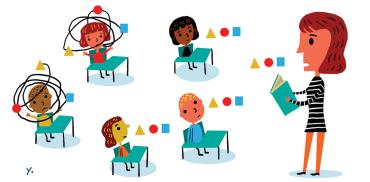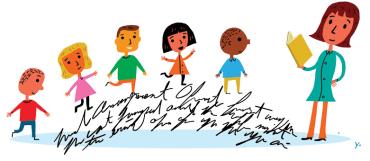Ms. Turner tossed and turned in bed, worrying about tomorrow’s class. The last time she led science lab work with her eighth-grade students, it had descended into chaos. The children all raced to grab the same equipment, in spite of her carefully prepared lesson plan and instructions. As they pushed each other, argued, and misused and damaged the equipment, Ms. Turner lost her cool and started yelling. How was she going to avoid this happening again tomorrow?
Classroom behavior is a source of anxiety, stress, and distraction for many teachers and is a key reason teachers give for leaving the profession.1 This often raises questions regarding the extent to which teacher preparation programs and initial teaching placements prepare pre-service teachers for working with students who display challenging behavior, regardless of its basis. In fact, teachers have a broad range of widely applicable strategies they may use in the classroom, such as moving toward a misbehaving student or positively reinforcing appropriate behaviors.
Strategies such as these2 are an essential part of a teacher’s toolkit, but some students require more specific, tiered interventions. One of the more dangerous myths about teaching is that if teachers plan lessons that are engaging enough, students will behave well. This leads to teachers blaming themselves for student misbehavior and ignores all the other influences that affect a child, such as conflict at home, poor nutrition, and previous school experiences. It also neglects the fact that some children have a specific developmental disorder that affects their processing of information, and hence their learning and behavior.
Some developmental disorders, such as attention deficit hyperactivity disorder (ADHD), are widely known, albeit possibly overdiagnosed and subject to ongoing debate regarding optimal management strategies. Less widely known and understood, however, is the impact of developmental language disorder (DLD) on behavior and learning. Based on the statistics, the odds are good that this is an issue that at least a few students are dealing with in Ms. Turner’s eighth-grade science class.3 The good news is that knowledge of difficulties associated with DLD may help teachers not only better deal with challenging behaviors but also improve learning outcomes for students with language disorders, as well as those outside the clinical range who nevertheless display difficulties processing and using oral language. Before considering DLD more closely, however, we need to consider what language skills are and why they are relevant to school success.
The Importance of Oral Language Skills
Oral language skills refer to the ability to understand the spoken language of others and the ability to express oneself verbally by putting words and ideas into sentences and engaging appropriately in different social situations. One of the most important roles of adults in children’s lives is to teach them the all-important yet unwritten rules of how to behave in a range of social, educational, vocational, and recreational contexts. This work is in equal parts demanding, time-consuming, challenging, amusing, frustrating, repetitive, and (in the long run at least) rewarding. It involves parents and other adults taking the reins in infancy and the preschool years to provide high levels of support, scaffolding, explicit instruction, timely feedback, and repeated opportunities for mastery regarding children’s emergent use of language.
As children enter toddlerhood and interact with a wider range of peers and adults, the unpredictability of their social world increases exponentially, and it is impossible for parents or teachers to preempt or intervene in every possible interaction a child will take part in. Instead, they provide this support across many interactions in a day, while over time tapering their level of direct oversight and stepping in when the child or adolescent stumbles.
Fitting in socially at school is crucial to making and keeping friends and to succeeding academically. Being socially competent is generally more difficult for young people with certain disabilities, as social competence is highly sensitive both to developmental level and to disabilities, some of which (such as DLD and mild forms of autism spectrum disorder) are not always formally diagnosed.
Speech-language pathologists use the term “pragmatic language competence” to refer to a speaker’s ability to get it right when interacting with others, and they study both the emergence of this skill across childhood and adolescence, and the ways it is compromised by a range of clinical conditions across a person’s lifetime. “Getting it right” refers to the ability to draw on executive functions such as planning, attention and concentration, and self-monitoring; to use core language skills (especially vocabulary and syntax) and social cognition skills that allow inferencing (i.e., drawing conclusions from incomplete or ambiguous information); and to resolve mismatches between verbal and nonverbal communication.
Imagine the child who, on being introduced to a distant relative for the first time, asks, “Why have you got hair growing out of your nose?” Most families have amusing, if sometimes excruciating, stories to tell of toddlers whose still coarse pragmatic language abilities meant that an alarming level of candor was used in a social situation. Such blunt honesty can often be laughed off when it comes from a 3-year-old, but it can cause serious social consequences if the speaker is 9 or even only 6 years old. Under typical circumstances, all aspects of pragmatic language ability strengthen with development, though there are generally a lot of stumbles and teachable moments along the way. The inner workings of the ways that we interact with each other as functioning adults are complex and often not obvious. A comment that is perfectly acceptable in one context may draw a hostile or indifferent reaction in another. This reflects the difficulty children and adolescents have in understanding social situations, considering the perspective of the other speaker, and learning subtle rules about when and why it is acceptable to communicate in a particular way.
Most of us have, at some point, misread a social cue, had a lapse in attention, or let our guard down in such a way that we inadvertently tore the social fabric. This might occur in the form of what we think is a witty retort that is actually received as offensive, or when we misunderstand the information a communication partner is seeking and we “answer” a question that was not the one asked. Happily, most of us are equipped to recognize such instances and swiftly repair the exchange to reduce the risk that anyone loses face or is confused, misled, or offended.
What Is Developmental Language Disorder?
Researchers have learned in recent years that a much larger than previously realized number of children and adolescents have difficulties processing and using spoken language and reading social and linguistic cues, and that they are prone to having their pragmatic language difficulties misunderstood and mischaracterized by adults. These children have what is now referred to as developmental language disorder.4 DLD refers to listening and/or speaking abilities that fall significantly below those expected on the basis of age. This disorder may occur on its own or alongside another impairment or disability, such as autism, intellectual disability, or an acquired brain injury.
Knowing about DLD is important for teachers, because its presence is sometimes masked by other difficulties, especially behaviors that appear inattentive and noncompliant. At the extreme end of the spectrum, there is a substantial body of literature showing high rates of previously undiagnosed language disorder in young people who are in contact with the criminal justice system.5 Although reported rates of such difficulties vary across nations, they are typically in the range of 50–60 percent,6 far outstripping estimates that place the prevalence of language disorders in the community at 7–10 percent.7
Considered in the context of the school-to-prison pipeline, these findings call attention to the close association between language difficulties and disruptive behavior, particularly in the context of other risks, such as living in a disadvantaged community. Schools can work to keep such young people engaged with education as a means of countering antisocial influences. When language and behavior difficulties occur together, it is the behavior difficulties that are likely to be a focus for parents and teachers, because these cause the greatest level of day-to-day disruption for everyone—the affected students, their peers, and the adults in their world. Intervening solely at the level of behavior may not, however, address the root causes, such as difficulties understanding teacher requests.8
Knowing that young people who come into contact with the criminal justice system are much more likely than their typically developing peers to have difficulties using and understanding everyday language9 helps us to understand two key issues for such students: why they struggle with verbal interactions, and why their reading, writing, and spelling skills are typically so poor. Reading is fundamentally a linguistic activity, and students with poor language skills struggle with the transition from the spoken word to the written word in the early years of school. Those who do not successfully transition from learning to read to reading to learn often also display inattentive and disruptive behavior in the classroom.10
Children with DLD have differing core language skills, such as in their use of vocabulary and sentence structure, but most struggle to read social cues and so experience the following problems:
- Knowing when to talk and when to listen, including how to appropriately interrupt the other speaker;
- Knowing how to introduce and change topics;
- Being able to follow shifts and segues in discussions, whether one-on-one or in groups;
- Being able to retain and then follow multistage commands, such as, “Once you have answered the question on page 10, draw a line on your page and write a new heading, ‘The Aztecs.’ ” It is impossible to discern how much such difficulties reflect poor working memory (see below) and how much they are due to reduced comprehension abilities. The bottom line is that affected students will grasp only one or two components of the instructions above;
- Knowing how to begin and end conversations in appropriate ways;
- Taking in instructions in an environment with background noise and other distractions;
- Producing connected spoken language in order to share their own experiences (narrative discourse); explain how something works, such as the rules of a game (procedural discourse); or give a classroom presentation on a curriculum-based topic (expository discourse);
- Understanding that the nature of their relationship with the other speaker will influence the communication style. For example, we display respect for authority figures by stopping what we are doing when they speak to us, by not fidgeting, by allowing the more senior partner to select and conclude topics, and by ensuring that we do not say or do things that might be construed as disrespectful, such as appearing to mock the other speaker; and
- Discerning direct communication from humor, sarcasm, irony, metaphor, and other forms of nonliteral, figurative language. Figurative language is so much a part of everyday language that we are often unaware of its presence in our conversations. Figurative language is the spice of everyday communication, but as such it can add complex flavors that make language hard for some children and adolescents to understand.
Sometimes children with language disorders are given related but less-than-specific diagnostic labels, such as ADHD, which can exist alongside language disorders. Labels such as these may be appropriate, in the sense that children can meet diagnostic criteria for more than one disorder at a time (a phenomenon referred to as comorbidity). However, sometimes misdiagnosis occurs, and this is more likely in clinical and educational settings in which DLD is poorly understood. Because language disorders impact written language as well, the reading and writing skills of affected students will fall behind those of their peers. In turn, this deepens the struggle these children experience every day in the classroom, in terms of managing the increasingly complex written demands of the academic curriculum.
Students with language disorders often make their presence felt in the classroom by struggling to keep up academically and socially, and by missing or misreading social cues. It has been said that “learning floats on a sea of talk,”11 and if you are not as proficient as at least the average child in the classroom with respect to your verbal abilities, you will be left behind. Perhaps worse still, you may acquire a label such as “inattentive,” “rude,” or “disengaged.” Labels are double-edged swords in schools. They are sometimes necessary in order to gain access to additional services but can also cause adults to prejudge a child and be prone to a range of cognitive biases as a consequence.
What Is the Role of Cognitive Abilities in Supporting Everyday Language and Learning Skills?
A child’s executive functions are an important contributing factor to pragmatic language competence. These include the ability to focus and sustain attention, to plan and organize behavior, to self-monitor and self-regulate, and to curb impulsiveness. Executive abilities such as these are associated with maturation in the prefrontal regions of the brain. These areas mature considerably later than other cortical areas (typically around the early 20s),12 and so it is not surprising that executive functions are very much under construction in school-age children. It is also important to note that neurobiological disabilities are common in school-age children. This means that the abilities of students with developmental language disorder, ADHD, and/or autism are likely to be more fragile with respect to these important drivers of academic success.
Another important consideration is the fact that working memory is limited. Working memory roughly corresponds to what we are consciously thinking about and processing at any given time.13 The capacity of working memory is currently thought to be limited to about four items.14 These constraints apply to individuals without a learning disability, but there is evidence15 that working memory may be even more constrained for students with disorders such as DLD.
A learning theory known as cognitive load theory specifically addresses working memory limits. In essence, each task we perform, including learning tasks, imposes a “cognitive load” on working memory. As educators, we try and optimize this load. For complicated tasks that are relatively new to the learner, this involves reducing the number of items the learner must pay attention to, which can be achieved in a number of ways.16 One approach is to provide students with fully worked examples or models. In addition, to avoid imposing any unnecessary cognitive load, it’s best not to show students a presentation with lots of distracting animations that are not essential to the point the teacher is trying to make.* Similarly, it’s best to avoid asking students to read a text while you simultaneously explain the meaning of the text or summarize its messages, as such explanations force them to divide their attention. These may sound like obvious points, but, in our experience, they commonly occur when teachers present new material. On the other hand, it appears that working memory has separate channels for processing visual and verbal information. As a result, we can work around some of the working memory limits by using a relevant visual image, such as a diagram, alongside a spoken explanation of the image.
These effects have been validated by a large number of controlled experiments. And there is strong evidence that applying these principles may also aid motivation,17 as students experience a sense of achievement rather than a sense of frustration.
How Can Understanding DLD Inform Teachers’ Classroom Practice?
Language skills are closely related to cognitive processes such as information processing, problem solving, and shifting from the concrete to the abstract. As such, idiomatic language and multistage instructions do have a place in the classroom, and children should be expected to produce and understand spoken and written language across a range of genres, in line with curriculum requirements. However, teachers need to consider children’s developmental capacities and the possibility, for example, that they have not had prior exposure to expressions that sometimes only make sense when they are explained in context. Asking a new student “Have you found your feet yet?” seems straightforward, yet the literal meaning is a significant linguistic distance away from the intended meaning of “How are you settling in?” A whole host of English idioms work in a similar way, with the literal meaning—the meaning that students may take from the phrase—being baffling or absurd. Imagine asking a student with language difficulties, “Does that ring a bell?” or “Can I twist your arm?” Imagine suggesting a student stop “Shooting the breeze” or telling him to “Keep your chin up.” In fact, it is easy to imagine these things, because this kind of language is widely used in everyday interactions.
Similarly, sarcasm and irony, although important to an understanding of some texts, should be avoided in giving classroom directions. Sarcasm involves saying the opposite of what you actually mean, and so there is a significant risk that children with DLD will receive the opposite message to the one you intended.
It is also worth noting that children with pragmatic language impairments may need explicit teaching in expected norms. Most people pick up conventions around language from a process of immersion—our ability to do so has been described as “biologically primary”18 and is a long but relatively effortless process we barely even notice. This can make it difficult for us to empathize with students who struggle to learn these conventions. The first step should therefore be to make expected norms clear and explicit. A student who constantly interrupts the teacher in class, for instance, should have this behavior calmly highlighted, receive an explanation as to why it is unacceptable, and be given specific targets to achieve, in incremental and achievable steps. This represents a structured intervention beyond the kinds of generic classroom management strategies discussed earlier.
Teachers who have access to the services of a speech-language pathologist may be able to request a formal assessment of language skills in students they are concerned about, and can work with that professional to support those students. Teachers are not clinicians and are not in a position to formally diagnose DLD on their own. Nevertheless, recognition of the possibility may help you tailor classroom supports and gain access to interventions.
These supports will not only help students with DLD but also aid students who do not come from an English language background and who are therefore less familiar with English idioms and expressions. And there is other good news: teaching strategies likely to help students with DLD may actually benefit all students, both in terms of motivation and support in reaching particular standards.
Verbal communication is the basis for everything that occurs in classrooms, whether this is the delivery of new information or the regulation of behavior. Although language skills are biologically primary, their development in children of the same age can be highly uneven. Further, a significant proportion of children in any class may have developmental language disorders, which may or may not have been formally diagnosed. Such disorders typically impact a student’s success with spoken and written language.
Back to Ms. Turner and her science class. Given what we know about DLD, what are the implications for her teaching? First, she could consider establishing a number of routines for the start of class. Such routines would result in her needing to communicate fewer instructions. These routines could form part of a wider classroom management strategy that draws on both verbal and nonverbal cues.
Second, Ms. Turner could keep in mind the working memory constraints that apply to all her students and ensure that she provides only a small amount of new information at any given time. Long lists of lab instructions could be broken down into smaller chunks, with new information provided after each step has been completed. It would also help her students if she avoided using idiomatic or unusual language, sarcasm, and irony, and realized that the way some students communicate with her may not always follow accepted adult norms, and that these students may need help to develop these skills. Ms. Turner could seek the input of professionals, such as speech-language pathologists, who can offer advice on specific student needs.
These steps will never solve every problem that arises in a complex environment full of young people. But they can help teachers develop a more preventive approach.
Greg Ashman is a teacher, blogger, and PhD candidate at the University of New South Wales in Australia, where he researches cognitive load theory. He is the author of The Truth about Teaching: An Evidence-Informed Guide for New Teachers. Pamela Snow is a professor at and head of the La Trobe Rural Health School in Bendigo, Australia. A speech-language pathologist and psychologist, she is a coauthor of Making Sense of Interventions for Children with Developmental Disorders: A Guide for Parents and Professionals.
*For more on avoiding such distractions, see “Keep It Simple to Avoid Data Distractions” in the Summer 2013 issue of American Educator. (back to article)
Endnotes
1. See I. Prilleltensky et al., “Teacher Stress: What It Is, Why It’s Important, How It Can Be Alleviated,” Theory Into Practice 55, no. 2 (2016): 104–111.
2. See G. Ashman, The Truth about Teaching: An Evidence-Informed Guide for New Teachers (London: SAGE, 2018); and R. J. Marzano et al., Classroom Management That Works: Research-Based Strategies for Every Teacher (Alexandria, VA: ASCD, 2003).
3. C. F. Norbury et al., “The Impact of Nonverbal Ability on Prevalence and Clinical Presentation of Language Disorder: Evidence from a Population Study,” Journal of Child Psychology and Psychiatry 57, no. 11 (2016): 1247–1257.
4. Norbury et al., “The Impact of Nonverbal Ability.”
5. P. Snow, “Speech-Language Pathology and the Youth Offender: Epidemiological Overview and Roadmap for Future Speech-Language Pathology Research and Scope of Practice,” Language, Speech, and Hearing Services in Schools (2019): 1–16.
6. Snow, “Speech-Language Pathology.”
7. B. Tomblin et al., “The Prevalence of Specific Language Impairment in Kindergarten Children,” Journal of Speech and Hearing Research 40 (1997): 1245–1260.
8. C. A. Christle, K. Jolivette, and C. M. Nelson, “School Characteristics Related to High School Dropout Rates,” Remedial and Special Education 28, no. 6 (2007): 325–339.
9. N. J. Cohen et al., “Unsuspected Language Impairment in Psychiatrically Disturbed Children: Prevalence and Language and Behavioral Characteristics,” Journal of the American Academy of Child & Adolescent Psychiatry 32, no. 3 (1993): 595–603.
10. P. Snow, “Elizabeth Usher Memorial Lecture: Language Is Literacy Is Language—Positioning Speech-Language Pathology in Education Policy, Practice, Paradigms and Polemics,” International Journal of Speech-Language Pathology 18, no. 3 (2016): 216–228.
11. J. Britton, Language and Learning: The Importance of Speech in Children’s Development (New York: Penguin Books, 1970).
12. S. J. Blakemore and S. Choudhury, “Development of the Adolescent Brain: Implications for Executive Function and Social Cognition,” Journal of Child Psychology and Psychiatry 47, no. 3–4 (2006): 296–312.
13. A. Baddeley and G. Hitch, “Working Memory,” Psychology of Learning and Motivation 8 (1974): 47–89.
14. N. Cowan, “The Magical Number 4 in Short-Term Memory: A Reconsideration of Mental Storage Capacity,” Behavioral and Brain Sciences 24, no. 1 (2001): 87–114.
15. L. M. Archibald and S. E. Gathercole, “Short-Term and Working Memory in Specific Language Impairment,” International Journal of Language & Communication Disorders 41, no. 6 (2001): 675–693.
16. J. Sweller, J. J. G. van Merrienboer, and F. G. W. C Paas, “Cognitive Architecture and Instructional Design: 20 Years Later,” Educational Psychology Review (2019): 1–32.
17. A. Martin and P. Evans, “Load Reduction Instruction: Exploring a Framework That Assesses Explicit Instruction through to Independent Learning,” Teaching and Teacher Education 73 (2018): 203–214.
18. D. C. Geary, “Reflections of Evolution and Culture in Children’s Cognition: Implications for Mathematical Development and Instruction,” American Psychologist 50, no. 1 (1995): 24.




